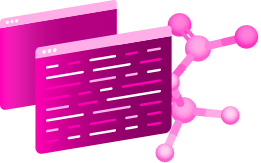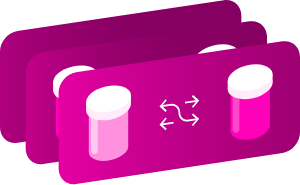Identification
- Generic Name
- Azimilide
- 博士ugBank Accession Number
- DB04957
- Background
-
Azimilide is an investigational class III anti-arrhythmic drug that blocks fast and slow components of the delayed rectifier cardiac potassium channels. It is not approved for use in any country, but is currently in clinical trials in the United States.
- Type
- Small Molecule
- Groups
- Investigational
- Structure
- Weight
-
Average: 457.96
Monoisotopic: 457.1880675 - Chemical Formula
- C23H28ClN5O3
- Synonyms
-
- Azimilide
Pharmacology
- Indication
-
Investigated for use/treatment in arrhythmia and atrial fibrillation.
 Reduce drug development failure ratesBuild, train, & validate machine-learning models
Reduce drug development failure ratesBuild, train, & validate machine-learning models
和以证据为基础的structured datasets.Build, train, & validate predictive machine-learning models with structured datasets. - Contraindications & Blackbox Warnings
-
 Avoid life-threatening adverse drug eventsImprove clinical decision support with information oncontraindications & blackbox warnings, population restrictions, harmful risks, & more.Avoid life-threatening adverse drug events & improve clinical decision support.
Avoid life-threatening adverse drug eventsImprove clinical decision support with information oncontraindications & blackbox warnings, population restrictions, harmful risks, & more.Avoid life-threatening adverse drug events & improve clinical decision support. - Pharmacodynamics
-
Azimilide is a new class III anti-arrhythmic agent. It is distinguished by a relative lack of reverse use-dependence, excellent oral absorption, no need for dose titration, an option for out-patient initiation, no need for adjustment associated with renal or liver failure and a lack of interaction with warfarin or digoxin. It carries some risk of torsade de pointes and rarely, neutropoenia.
- Mechanism of action
-
The mechanism of action of azimilide is to block both the slowly conducting (I(Ks)) and rapidly conducting (I(Kr)) rectifier potassium currents in cardiac cells. This differs from other class III agents that block I(Kr) exclusively or in combination with sodium, calcium, or transient outward (I(to)) potassium current channels. It also has blocking effects on sodium (I(Na)) and calcium currents (I(CaL)). Its effects on reentrant circuits in infarct border zones causing ventricular tachyarrhythmias are unknown.
Target Actions Organism UPotassium voltage-gated channel subfamily E member 1 Not Available Humans UPotassium voltage-gated channel subfamily KQT member 1 Not Available Humans UPotassium voltage-gated channel subfamily H member 2 Not Available Humans - Absorption
-
优秀的口服吸收。
- Volume of distribution
-
Not Available
- Protein binding
-
Not Available
- Metabolism
-
The metabolic fate of azimilide in man is unusual as it undergoes a cleavage in vivo resulting in the formation of two classes of structurally distinct metabolites. One study has shown that a cleaved metabolite, 4-chloro-2-phenyl furoic acid was present at high concentration in plasma, while other plasma metabolites, azimilide N-oxide, and a cleaved hydantoin metabolite were present at lower concentrations than azimilide. In urine, the cleaved metabolites were the major metabolites, (> 35% of the dose) along with phenols (as conjugates, 7%-8%), azimilide N-oxide (4%-10%), a butanoic acid metabolite (2%-3%), and desmethyl azimilide (2%). A limited investigation of fecal metabolites indicated that azimilide (3%-5%), desmethyl azimilide (1%-3%), and the butanoic acid metabolite (< 1%) were present. Contributing pathways for metabolism of azimilide, identified through in vitro and in-vivo studies, were CYPs 1A1 (est. 28%), 3A4/5 (est. 20%), 2D6 (< 1%), FMO (est. 14%), and cleavage (35%). Enzyme(s) involved in the cleavage of azimilide were not identified.
- Route of elimination
-
Not Available
- Half-life
-
Not Available
- Clearance
-
Not Available
- Adverse Effects
-
 Improve decision support & research outcomesWith structured adverse effects data, including:blackbox warnings, adverse reactions, warning & precautions, & incidence rates.Improve decision support & research outcomes with our structured adverse effects data.
Improve decision support & research outcomesWith structured adverse effects data, including:blackbox warnings, adverse reactions, warning & precautions, & incidence rates.Improve decision support & research outcomes with our structured adverse effects data. - Toxicity
-
Not Available
- Pathways
- Not Available
- Pharmacogenomic Effects/ADRsBrowse all" title="" id="snp-actions-info" class="drug-info-popup" href="javascript:void(0);">
- Not Available
Interactions
- 博士ug InteractionsLearn More" title="" id="structured-interactions-info" class="drug-info-popup" href="javascript:void(0);">
-
This information should not be interpreted without the help of a healthcare provider. If you believe you are experiencing an interaction, contact a healthcare provider immediately. The absence of an interaction does not necessarily mean no interactions exist.
博士ug Interaction Integrate drug-drug
interactions in your softwareAbametapir The serum concentration of Azimilide can be increased when it is combined with Abametapir. Abatacept The metabolism of Azimilide can be increased when combined with Abatacept. Acalabrutinib The metabolism of Azimilide can be decreased when combined with Acalabrutinib. Acebutolol Acebutolol may increase the arrhythmogenic activities of Azimilide. Acetyldigitoxin Acetyldigitoxin may increase the arrhythmogenic activities of Azimilide. Acrivastine The risk or severity of QTc prolongation can be increased when Acrivastine is combined with Azimilide. Adalimumab The metabolism of Azimilide can be increased when combined with Adalimumab. Adenosine Adenosine may increase the arrhythmogenic activities of Azimilide. Ajmaline Ajmaline may increase the arrhythmogenic activities of Azimilide. Alfentanil The metabolism of Azimilide can be decreased when combined with Alfentanil.  Identify potential medication risksEasily compare up to 40 drugs with our drug interaction checker.Get severity rating, description, and management advice.Learn more
Identify potential medication risksEasily compare up to 40 drugs with our drug interaction checker.Get severity rating, description, and management advice.Learn more - Food Interactions
- Not Available
Products
-
 博士ug product information from 10+ global regionsOur datasets provide approved product information including:
博士ug product information from 10+ global regionsOur datasets provide approved product information including:
dosage, form, labeller, route of administration, and marketing period.Access drug product information from over 10 global regions. - International/Other Brands
- Stedicor
Categories
- 博士ug Categories
-
- Antiarrhythmic agents
- Antiarrhythmics, Class III
- Calcium-Regulating Hormones and Agents
- Cardiovascular Agents
- Cytochrome P-450 CYP2D6 Substrates
- Cytochrome P-450 CYP3A Substrates
- Cytochrome P-450 CYP3A4 Substrates
- Cytochrome P-450 CYP3A5 Substrates
- 细胞色素p - 450基质
- Imidazoles
- Imidazolidines
- Membrane Transport Modulators
- Moderate Risk QTc-Prolonging Agents
- QTc Prolonging Agents
- Chemical TaxonomyProvided byClassyfire
-
- Description
- This compound belongs to the class of organic compounds known as hydantoins. These are heterocyclic compounds containing an imidazolidine substituted by ketone group at positions 2 and 4.
- Kingdom
- Organic compounds
- Super Class
- Organoheterocyclic compounds
- Class
- Azolidines
- Sub Class
- Imidazolidines
- Direct Parent
- Hydantoins
- Alternative Parents
- Alpha amino acids and derivatives/N-methylpiperazines/Chlorobenzenes/Semicarbazones/Aryl chlorides/Heteroaromatic compounds/Furans/Dicarboximides/Trialkylamines/Organic carbonic acids and derivatives show 7 more
- Substituents
- 1,4-diazinane/Alpha-amino acid or derivatives/Amine/Amino acid or derivatives/Aromatic heteromonocyclic compound/Aryl chloride/Aryl halide/Azacycle/Benzenoid/Carbonic acid derivative show 26 more
- Molecular Framework
- Aromatic heteromonocyclic compounds
- External Descriptors
- Not Available
- Affected organisms
-
- Humans and other mammals
Chemical Identifiers
- UNII
- 74QU6P2934
- CAS number
- 149908-53-2
- InChI Key
- MREBEPTUUMTTIA-UHFFFAOYSA-N
- InChI
-
InChI=1S/C23H28ClN5O3/c1-26-12-14-27(15-13-26)10-2-3-11-28-22(30)17-29(23(28)31)25-16-20-8-9-21(32-20)18-4-6-19(24)7-5-18/h4-9,16H,2-3,10-15,17H2,1H3
- IUPAC Name
-
1-({[5-(4-chlorophenyl)furan-2-yl]methylidene}amino)-3-[4-(4-methylpiperazin-1-yl)butyl]imidazolidine-2,4-dione
- SMILES
-
CN1CCN(CCCCN2C(=O)CN(N=CC3=CC=C(O3)C3=CC=C(Cl)C=C3)C2=O)CC1
References
- General References
-
- Schmitt H, Cabo C, Coromilas JC, Wit AL: Effects of azimilide, a new class III antiarrhythmic drug, on reentrant circuits causing ventricular tachycardia and fibrillation in a canine model of myocardial infarction. J Cardiovasc Electrophysiol. 2001 Sep;12(9):1025-33. [Article]
- Abrol R, Page RL: Azimilide dihydrochloride: a new class III anti-arrhythmic agent. Expert Opin Investig Drugs. 2000 Nov;9(11):2705-15. [Article]
- Tran HT: Azimilide dihydrochloride: a unique class III antiarrhythmic agent. Heart Dis. 1999 May-Jun;1(2):114-6. [Article]
- Toothaker RD, Corey AE, Valentine SN, Agnew JR, Parekh N, Moehrke W, Thompson GA, Powell JH: Influence of coadministration on the pharmacokinetics of azimilide dihydrochloride and digoxin. J Clin Pharmacol. 2005 Jul;45(7):773-80. [Article]
- Riley P, Figary PC, Entwisle JR, Roe AL, Thompson GA, Ohashi R, Ohashi N, Moorehead TJ: The metabolic profile of azimilide in man: in vivo and in vitro evaluations. J Pharm Sci. 2005 Sep;94(9):2084-95. [Article]
- External Links
Clinical Trials
- Clinical TrialsLearn More" title="" id="clinical-trials-info" class="drug-info-popup" href="javascript:void(0);">
-
Phase Status Purpose Conditions Count 3 Terminated Treatment Arrhythmia/Cardiovascular Disease (CVD)/Implantable Cardioverter-defibrillators (ICDs) 1 2 Completed Treatment Congestive Heart Failure (CHF) 1
Pharmacoeconomics
- Manufacturers
-
Not Available
- Packagers
-
Not Available
- Dosage Forms
- Not Available
- Prices
- Not Available
- Patents
- Not Available
Properties
- State
- 固体
- Experimental Properties
- Not Available
- Predicted Properties
-
Property Value Source Water Solubility 0.0861 mg/mL ALOGPS logP 2.91 ALOGPS logP 2.59 Chemaxon logS -3.7 ALOGPS pKa (Strongest Acidic) 11.95 Chemaxon pKa (Strongest Basic) 8.7 Chemaxon Physiological Charge 1 Chemaxon Hydrogen Acceptor Count 5 Chemaxon Hydrogen Donor Count 0 Chemaxon Polar Surface Area 72.6 Å2 Chemaxon Rotatable Bond Count 8 Chemaxon Refractivity 124.83 m3·mol-1 Chemaxon Polarizability 50.15 Å3 Chemaxon Number of Rings 4 Chemaxon Bioavailability 1 Chemaxon Rule of Five Yes Chemaxon Ghose Filter Yes Chemaxon Veber's Rule No Chemaxon MDDR-like Rule Yes Chemaxon - Predicted ADMET Features
-
Property Value Probability Human Intestinal Absorption + 1.0 Blood Brain Barrier + 0.9013 Caco-2 permeable - 0.5057 P-glycoprotein substrate Substrate 0.7072 P-glycoprotein inhibitor I Inhibitor 0.79 P-glycoprotein inhibitor II Non-inhibitor 0.5948 Renal organic cation transporter Inhibitor 0.614 CYP450 2C9 substrate Non-substrate 0.7463 CYP450 2D6 substrate Non-substrate 0.9116 CYP450 3A4 substrate Substrate 0.7085 CYP450 1A2 substrate Non-inhibitor 0.8317 CYP450 2C9 inhibitor Non-inhibitor 0.7377 CYP450 2D6 inhibitor Non-inhibitor 0.8987 CYP450 2C19 inhibitor Inhibitor 0.5383 CYP450 3A4 inhibitor Non-inhibitor 0.8177 CYP450 inhibitory promiscuity Low CYP Inhibitory Promiscuity 0.8234 Ames test AMES toxic 0.5429 Carcinogenicity Non-carcinogens 0.7114 Biodegradation Not ready biodegradable 0.9967 Rat acute toxicity 2.6412 LD50, mol/kg Not applicable hERG inhibition (predictor I) Strong inhibitor 0.8037 hERG inhibition (predictor II) Inhibitor 0.5718
Spectra
- Mass Spec (NIST)
- Not Available
- Spectra
-
Spectrum Spectrum Type Splash Key Predicted MS/MS Spectrum - 10V, Positive (Annotated) Predicted LC-MS/MS Not Available Predicted MS/MS Spectrum - 20V, Positive (Annotated) Predicted LC-MS/MS Not Available Predicted MS/MS Spectrum - 40V, Positive (Annotated) Predicted LC-MS/MS Not Available Predicted MS/MS Spectrum - 10V, Negative (Annotated) Predicted LC-MS/MS Not Available Predicted MS/MS Spectrum - 20V, Negative (Annotated) Predicted LC-MS/MS Not Available Predicted MS/MS Spectrum - 40V, Negative (Annotated) Predicted LC-MS/MS Not Available
Targets

insights and accelerate drug research.
- Kind
- Protein
- Organism
- Humans
- Pharmacological action
-
Unknown
- General Function
- Telethonin binding
- Specific Function
- Ancillary protein that assembles as a beta subunit with a voltage-gated potassium channel complex of pore-forming alpha subunits. Modulates the gating kinetics and enhances stability of the channel...
- Gene Name
- KCNE1
- Uniprot ID
- P15382
- Uniprot Name
- Potassium voltage-gated channel subfamily E member 1
- 分子量
- 14674.66 Da
References
- Schmitt H, Cabo C, Coromilas JC, Wit AL: Effects of azimilide, a new class III antiarrhythmic drug, on reentrant circuits causing ventricular tachycardia and fibrillation in a canine model of myocardial infarction. J Cardiovasc Electrophysiol. 2001 Sep;12(9):1025-33. [Article]
- Abrol R, Page RL: Azimilide dihydrochloride: a new class III anti-arrhythmic agent. Expert Opin Investig Drugs. 2000 Nov;9(11):2705-15. [Article]
- Kind
- Protein
- Organism
- Humans
- Pharmacological action
-
Unknown
- General Function
- Voltage-gated potassium channel activity involved in ventricular cardiac muscle cell action potential repolarization
- Specific Function
- Potassium channel that plays an important role in a number of tissues, including heart, inner ear, stomach and colon (By similarity) (PubMed:10646604). Associates with KCNE beta subunits that modul...
- Gene Name
- KCNQ1
- Uniprot ID
- P51787
- Uniprot Name
- Potassium voltage-gated channel subfamily KQT member 1
- 分子量
- 74697.925 Da
References
- Schmitt H, Cabo C, Coromilas JC, Wit AL: Effects of azimilide, a new class III antiarrhythmic drug, on reentrant circuits causing ventricular tachycardia and fibrillation in a canine model of myocardial infarction. J Cardiovasc Electrophysiol. 2001 Sep;12(9):1025-33. [Article]
- Abrol R, Page RL: Azimilide dihydrochloride: a new class III anti-arrhythmic agent. Expert Opin Investig Drugs. 2000 Nov;9(11):2705-15. [Article]
- Kind
- Protein
- Organism
- Humans
- Pharmacological action
-
Unknown
- General Function
- Voltage-gated potassium channel activity involved in ventricular cardiac muscle cell action potential repolarization
- Specific Function
- Pore-forming (alpha) subunit of voltage-gated inwardly rectifying potassium channel. Channel properties are modulated by cAMP and subunit assembly. Mediates the rapidly activating component of the ...
- Gene Name
- KCNH2
- Uniprot ID
- Q12809
- Uniprot Name
- Potassium voltage-gated channel subfamily H member 2
- 分子量
- 126653.52 Da
References
- Schmitt H, Cabo C, Coromilas JC, Wit AL: Effects of azimilide, a new class III antiarrhythmic drug, on reentrant circuits causing ventricular tachycardia and fibrillation in a canine model of myocardial infarction. J Cardiovasc Electrophysiol. 2001 Sep;12(9):1025-33. [Article]
- Abrol R, Page RL: Azimilide dihydrochloride: a new class III anti-arrhythmic agent. Expert Opin Investig Drugs. 2000 Nov;9(11):2705-15. [Article]
酶
- Kind
- Protein
- Organism
- Humans
- Pharmacological action
-
Unknown
- Actions
-
Substrate
- General Function
- Steroid hydroxylase activity
- Specific Function
- Responsible for the metabolism of many drugs and environmental chemicals that it oxidizes. It is involved in the metabolism of drugs such as antiarrhythmics, adrenoceptor antagonists, and tricyclic...
- Gene Name
- CYP2D6
- Uniprot ID
- P10635
- Uniprot Name
- Cytochrome P450 2D6
- 分子量
- 55768.94 Da
References
- Riley P, Figary PC, Entwisle JR, Roe AL, Thompson GA, Ohashi R, Ohashi N, Moorehead TJ: The metabolic profile of azimilide in man: in vivo and in vitro evaluations. J Pharm Sci. 2005 Sep;94(9):2084-95. [Article]
- Kind
- Protein
- Organism
- Humans
- Pharmacological action
-
Unknown
- Actions
-
Substrate
- General Function
- Vitamin d 24-hydroxylase activity
- Specific Function
- Cytochromes P450 are a group of heme-thiolate monooxygenases. In liver microsomes, this enzyme is involved in an NADPH-dependent electron transport pathway. It oxidizes a variety of structurally un...
- Gene Name
- CYP1A1
- Uniprot ID
- P04798
- Uniprot Name
- 细胞色素P450 1 a1
- 分子量
- 58164.815 Da
References
- Riley P, Figary PC, Entwisle JR, Roe AL, Thompson GA, Ohashi R, Ohashi N, Moorehead TJ: The metabolic profile of azimilide in man: in vivo and in vitro evaluations. J Pharm Sci. 2005 Sep;94(9):2084-95. [Article]
- Kind
- Protein
- Organism
- Humans
- Pharmacological action
-
Unknown
- Actions
-
Substrate
- General Function
- Vitamin d3 25-hydroxylase activity
- Specific Function
- Cytochromes P450 are a group of heme-thiolate monooxygenases. In liver microsomes, this enzyme is involved in an NADPH-dependent electron transport pathway. It performs a variety of oxidation react...
- Gene Name
- CYP3A4
- Uniprot ID
- P08684
- Uniprot Name
- Cytochrome P450 3A4
- 分子量
- 57342.67 Da
References
- Riley P, Figary PC, Entwisle JR, Roe AL, Thompson GA, Ohashi R, Ohashi N, Moorehead TJ: The metabolic profile of azimilide in man: in vivo and in vitro evaluations. J Pharm Sci. 2005 Sep;94(9):2084-95. [Article]
- Kind
- Protein
- Organism
- Humans
- Pharmacological action
-
Unknown
- Actions
-
Substrate
- General Function
- Oxygen binding
- Specific Function
- Cytochromes P450 are a group of heme-thiolate monooxygenases. In liver microsomes, this enzyme is involved in an NADPH-dependent electron transport pathway. It oxidizes a variety of structurally un...
- Gene Name
- CYP3A5
- Uniprot ID
- P20815
- Uniprot Name
- Cytochrome P450 3A5
- 分子量
- 57108.065 Da
References
- Riley P, Figary PC, Entwisle JR, Roe AL, Thompson GA, Ohashi R, Ohashi N, Moorehead TJ: The metabolic profile of azimilide in man: in vivo and in vitro evaluations. J Pharm Sci. 2005 Sep;94(9):2084-95. [Article]
博士ug created at October 21, 2007 22:23 / Updated at February 21, 2021 18:51




